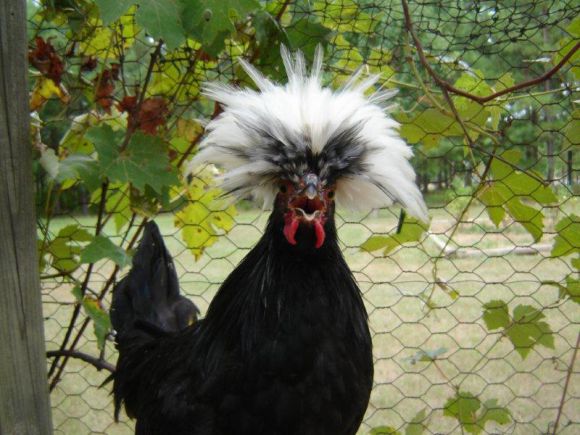
My Favorite Chickens

They are all listed in the bible of the industry, The American Standard of Perfection, where, if you so choose, you can peruse them at your leisure. There you will find my favorite three, along with such odd birds as White Faced Spanish, Jersey Giants, Buttercups, Silver Gray Dorkings, Red Caps and Belgian Bearded d'Anvers.A Silkie doesn't have feathers - - - it has hair. Get it? A chicken with silky hair. Underneath that hair, the skin is a ghastly grayish-black. And in the midst of its forehead, if a chicken can be said to have a forehead, there is a single red button - - - a stand-in for the familiar comb of other, less interesting chickens.
A Polish has huge nostrils, and a mountain of feathers bunched up on the top of its little pointy-head. In the case of the so-called W.C. Black Polish, it's a startling eruption of white feathers in dramatic comparison to the black feathers down below, with - - - as the Standard denotes them - - - their "beetle sheen."
The Cochin, as befits its oriental heritage, is modesty itself. It wears its feathers all over its body, down its little chicken legs, all the way to its tootsies. A full-grown Cochin will appear like nothing more than a comb, a beak and glittering chicken eyes riding atop a mound of feathers. My favorite coloring of this breed is known as the "Barred Cochin"--- and it looks not unlike a huge ball of cut-up mattress ticking.
Thus friends - - - my hobby. And my love.
I hope you will forgive me.
I live in southern Mexico in the winter. Since transporting chickens is not at all like transporting dogs, or cats or even mountain lions - - - I have had to leave my pals behind in the United States during the winters I come down here to Puerto Perdido, 2,200 miles south of the border.
Various hard-hearted customs officials have told me that the transporting of chickens across international lines is illegal, akin to shipping guns or drugs. They say it is to protect local stocks against outbreaks of various diseases like chicken pox, egg-zema and ululating fever. I know what they tell me is a lie - - - that the rules are set up to keep us chicken-nuts separated from whatever it is that gives us so much pleasure.
However, as the philosophers have pointed out over the centuries, a chicken is an egg's way to make another egg. So, two years ago, in complete secrecy - - - I bought several dozen eggs from Murray McMurray Hatchery, the funny chicken merchants to the world. I wrapped them in sheets and towels, and shipped them south, along with a couple of incubators.
I didn't know until after the eggs hatched that - - - in the pursuit of guns and drugs and other illegals - - - all packages are X-rayed at the border, so those of my friends that finally wobbled out of their shells sported two heads and a few too many legs, among other oddities.
Pretty, and interesting - - - a two headed white-crested Polish is doubly astonishing - - - but, unfortunately, they didn't survive long enough to wow the world.
Last year, I had the egg cartons wrapped in lead, which cost a pretty penny. Proving that we chicken-heads will do everything for our habit. The eggs survived the trip, and the chicks that erupted from their shells grew to perfection in six months. They've caused a sensation here in Puerto Perdido.
The distinct types of my pals are referred to locally as "capetones y pantelones" - - - chickens with caps and chickens with pants. The Cochins especially have caught the fancy of the local young. They refer to them as "pollos cholos," cholos being those young Latino non-chickens you see running around the malls with their pants bunched down around the knee-level - - - what we used to call "droopy-drawers."
Everybody and his brother wants a pair of pantelones or capetones. Since my task is to populate the world with my favorite brand of chicks - - - I am giving them away willy-nilly, planning for an even-larger hatch for next winter.
And not being satisfied with Cochins and Polish, I am in the process of ordering from the Murray McMurray catalog, for next year, a set of Bearded Belgian d'Anvers - - - chickens with side-whiskers and little wooden clogs on their feet - - - and several White Faced Spanish, an Iberian breed that stays indoors out of the sun all summer long and eats long multi-course meals only after eleven at night.
There are, too, the Red Caps - - - birds that carry your bags for you, and (best of all) Jersey Giants. These last are bred on the East Coast to grow more than 5 feet tall, weigh in at 300 pounds, and crow raucously, deeply: "Hackensack!"